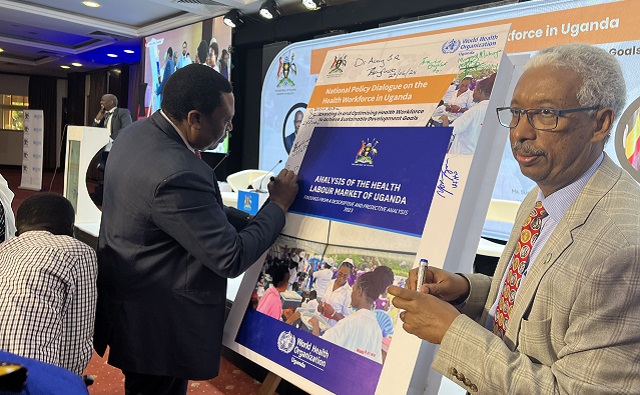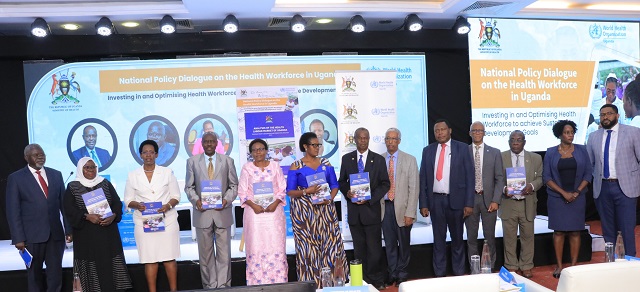
Country had a shortage of 190,000 health workers in 2022
Kampala, Uganda | RONALD MUSOKE | The government must strengthen its governance, stewardship, and financing structures to ensure that the training, recruitment and retention of the country’s health workforce is informed by the health needs of Ugandans.
The country’s resources must also be channeled to training priority cadres for the country’s health system as well as ensure that they are absorbed into the labour market to guarantee quality service delivery in Uganda.
These were some of the recommendations at a two-day policy dialogue held at the Serena Kampala Hotel on June 27-28 by the Ministry of Health in conjunction with the World Health Organisation (WHO). The dialogue held under the theme: “Investing in and Optimising health workforce to achieve Sustainable Development Goals” attracted policymakers, health planners and partners.
It followed an analysis of the findings from a health labour market study which was undertaken in 2023 by the Ministry of Health with support from WHO to understand better the human resources for health dynamics in Uganda.
Among the study’s objectives was the need to understand the willingness of the young generation in joining the health workforce, the capacity of the health training institutions to meet the demand for training, the stock of the available health workforce for service delivery, the migration and the distribution of this health workforce and the government’s ability to pay for recruitment of more health workers.
The study notes that an adequate number and skill mix of equitably distributed health workforce, are critical to achieving national health goals, universal health coverage and the health-related SDG targets.
“It’s common knowledge that without adequate skilled and motivated health workforce, the health sector cannot progress,” said Dr. Jane Ruth Aceng, the Minister of Health, during the dialogue. “I know that there are efforts to ensure that we have adequate and skilled workforce, but the efforts are not yet to the extent that is desirable.”
Dr. Charles Olaro, the Director of Health Services (Clinical Services) who represented Dr. Henry Mwebesa, the Director General, Health Services in the Ministry of Health noted how health service delivery is labour intensive and giving prominence to the health workforce will be crucial in attaining Uganda’s universal health coverage goals.
Study findings
According to the report, Uganda had a total of 210 health training institutions located in 66 districts in 2022 with the private sector owning 133 institutions ( 63%) of the total number of the institutions while government-owned institutions were just 47 (22%). The rest (14% or 30 institutions) were owned by the private not-for-profit organisations.
These training institutions have contributed to a rise in Uganda’s health workforce stock and density by 76% and 58% respectively between 2005 and 2022.
However, Dr. Flavia Mpanga Kaggwa, a health specialist at UNICEF Uganda expressed her reservations about the private sector taking the lead role in training about 63% of the country’s health workforce.
“We need to worry about the skills and competence that come out of the private sector,” she said, “If you don’t have a quality workforce at 75% staffing norms, the skills and competences can be questioned.”
In response, the Commissioner for Health Education and Training in the Ministry of Education and Sports, Safinah Museene, said the government has an inter-ministerial coordination committee that oversees training quality.
“We know very well that issues of quantity and quality of education have been highlighted,” she said. These include quality of trainers, instructional materials and facilities, the environment, issues of internship and apprenticeship and attachment as well as continuous professional development.
Stock of health workers
According to the report, the total stock of health workers in Uganda was estimated at 158,932 in 2022 with a density of 25.9 doctors, nurses, and midwives per 10,000 people. The highest number were nurses and midwives (106,915), followed by laboratory technicians (16,098) and clinical officers (13,627).
The nurses and midwives represent 67.3% of health workers, while laboratory technicians and clinical officers represent 10.1% and 8.6% of health workers, respectively. There were 7,793 (4.9%) medical doctors (general medical practitioners and specialists), 1,712 (1.1%) pharmacists and 504 dentists (0.3%).
The majority of Uganda’s health workforce were trained in Uganda, notes the study. Foreign trained health workers practicing in Uganda were mostly chiropractors (40%), optometrists (16%), medical doctors and specialists (8%), and physiotherapists (5%).
The proportion of foreign trained health workers was less than 3% for those working as occupational therapists, dental surgeons, medical imaging technologists, medical laboratory technologists and pharmacists.

Overall, in terms of sector of employment, the majority of nursing professionals (74%), and midwifery professionals (64%) were employed in the public sector, compared to 26%, and 36% employed in the private sector, respectively. About 61% of medical doctors and specialists were employed in the private sector, whilst 39% were employed in the public sector.
Rising stock of health workforce
According to the report, the stock of nurses, midwives, pharmacists, and doctors increased from the year 2012 to 2022. The proportion among the different cadres of health workers remained consistent, with the highest being for nurses.
However, the highest growth rate was observed for midwives (211%), followed by nurses (184%), pharmacists (178%) and medical doctors (51%). Out of the 7,793 medical doctors and specialists, 1,970 (25%) were employed in the public sector, whilst 3,058 (39%) were employed in the private sector and 2,780 (36%) were employed outside the health sector or unemployed.
For the nursing professionals, out of the 73,956 nurses, 18,687 (25%) were employed in the public sector, whilst 6,712 (9%) were employed in the private sector and 48,557 (66%) were employed outside the health sector or unemployed.
The percentage of health workers employed outside the health sector or unemployed was highest for pharmacists (89%) and midwifery professionals (68%). The highest employment rate for selected health workers in the health sector in Uganda in 2022 was observed for medical doctors and specialist at almost about 65%, whilst pharmacists had the lowest employment rate of about 10%.
Geographic distribution
Most doctors, nurses, and midwives work in Kampala, Uganda’s capital. Interestingly, Moroto in the remote northeastern region of Karamoja follows closely. This conclusion is reached because the researchers used what they called the “Human Resource for Health Geographical Equity Index (GEI)” approach.
This approach considers a district’s percentage share of the public service health workforce divided by its percentage share of national population to calculate the GEI. Kampala had a GEI of 41.2 (41.2 per 10,000) followed by Moroto (18.1:10,000), Butambala, Kabale, and Lyantonde. District with really low GEI were Kibaale (GEI – 0.8), Buyende, Kyenjojo, Kakumiro, and Kyegegwa (GEI – 0.6) as the lowest.
The GEI for doctors was lowest in Kyegegwa District followed by Nwoya, Kole and Kyankwanzi. The highest ratio for doctors was in Kampala and Moroto. Kampala and Moroto again had the highest GEI scores for nurses and midwives. The lowest GEI scores were recorded for Kasanda, Wakiso, Kaliro and Kagadi districts, then Kole, Bukedea, Buyende, Kyenjojo and Kakumiro, Kyegegwa and Kibaale districts trailing.
For pharmacists, only 30 of Uganda’s 135 districts had this cadre available with Kampala and Moroto having the highest GEI scores at 0.5 and 0.2. All districts had a medical laboratory professional cadre with Kalangala, Kasese, and Moroto districts having the highest scores.
Only 23 districts had an anesthetic officer in place with the highest GEI score being evident in Kamapala. Others included Mbarara, Moroto, Kabale, Kapchorwa, Jinja, Gulu, Kabarole, Masaka, Kiboga, Soroti and Hoima
Relatedly, the gender distribution of medical specialists shows that there were generally more males (approx. 70%) compared to women (approx.30%). Majority of nursing and midwifery professionals were females.
All enrolled midwives were female and almost 99% of registered midwives were females. About 73% of registered and 66% of enrolled nurses were females. On the contrary, most of registered mental health nurses (99%) and registered palliative care nurses were males (67%).
Youthful workforce
The study also notes that Uganda has a young health workforce with most health workers aged below 45 years. Most of the health workers are in the age range of 25 to 34 years seconded by those in the age range of between 35 and 44 years. These included isolated health workforce cadres such as Anesthetic Officers and Health Inspectors, and medical specialists. The old health workers of above 65+ years are mostly those working as Dental Surgeons. On the contrary, less than 10% of medical doctors and specialist were above 65 years.
Migration of health workers
The youthful nature of Uganda’s health labour force could also offer glimpses into why some of them are opting for greener pastures outside Uganda. According to the study, the trend of doctors requesting certificates of good standing for emigration increased by 97% within a 5-year period from 2014 to 2019. However, there were variations in the trends.
For instance, from 2014 to 2016, the number of health workers requesting for certificate of good standing for emigration by doctors increased steadily from 104 to 192 (85% increase). In 2017 the number dropped to 177 before it increased again to 226 in 2018 then dropped to 205 in 2019.
The majority of doctors were requesting for certificates of good standing to migrate to Seychelles and seconded by seven other countries (Ethiopia, Germany, New Zealand, Rwanda, Saudi Arabia, Sierra Leone, and South Africa). There are also other 21 countries where the doctors do migrate to from Uganda as per 2019 records of requests for certificate of good standing for emigration.
Dr. Sunny Okoroafor, the Regional Advisor on health workforce management and retention at the WHO Africa Regional Office, said Uganda needs to sign and implement health worker mobility bilateral agreements with countries benefiting from the migration of its health workforce. This should be done with the aim of strengthening Uganda’s health system to achieve its SDG targets should be followed up, he said.

Dr.Okoroafor also noted that regularly engaging with the executive and parliament to obtain sustained commitment to incrementally improve investment in the health sector to improve Uganda’s health sector financial space, and in health workforce development at national and district levels is critically needed.
“The Ugandan health workers have proven themselves to be a very important component of global health,” said Dr. Yonas Tegegn Woldemariam, the WHO Country Representative in Uganda, “We should invest in them, not only for Uganda but for their global contribution to collective health security.”
Interestingly, Dr. Woldemariam noted that the capacity to train health workers on the African continent has increased by 70% from 150,000 graduates in 2018 to more than 255,000 in 2022 in over 4000 institutions and programmes.
As of 2022, the African region had 27 doctors, nurses, midwives, dentists, and pharmacists per 10,000 people on average—over a two-fold increase from 11 per 10,000 people in 2013 and a 14% improvement from 2018.
“We must view spending on the health workforce as an investment to be nurtured, and not a cost to be contained. This investment yields significant returns in sustainable development, equity, and inclusive growth,” said Dr. Woldemariam.
Future supply of health workforce
According to the report, in 2022, Uganda had an estimated 154,073 health workers and these were spread across 49 staff categories. But the estimated need for health workers in 2022 was 342,832. The demand modeling shows Uganda had the capacity to hire 69,125 health professionals in 2023 based on the economic parameters and health expenditure patterns. If these parameters and spending patterns do not diminish, the capacity is expected to expand by 36% to only 94,158 by 2032, the report noted.
If the current production capacity is maintained at an average capacity and an attrition rate of 4% is considered, the supply of health workers is expected to increase to between 239,696 and 285,298 by 2032.
In contrast, Uganda needed 343,832 health workers in 2022. This is based on Uganda’s disease burden, population size, growth, and demographics, and a modelling of essential service provision, and health worker productivity. This need will almost double to 528,868 in 2032.
There is therefore need for a 19% increase in the number of health workers in order to achieve a 5% increase in the universal health care index threshold by 2032. But the needs vary across professionals with need for general practitioners anticipated to increase by 54% by 2032.
However, if you consider medical specialists – physicians/ internal medicine, obstetricians and gynecologists, general surgeons, pediatricians, emergency medicine practitioners, ear nose and throat surgeons, orthopedic surgeons, ophthalmologists, pathologists, radiologists, microbiologists , psychiatrists ananesthesiologist – Uganda’s disease burden and population demographics will require about about 7,748 specialist doctors, representing a 54% increase by 2032. Up to 346,551 midwives (enrolled and registered) will also be needed by 2030.
According to the report, for some categories of health workers, the need appears non-existent or underestimated. This, the report notes, should however be interpreted with caution as this does not depict that they are not needed.
Bigger health workforce budget needed
Meanwhile, the potential financial space for the health workforce, which is a combination of public and private sector contributions, was estimated to be US$ 688 million in 2023 but could increase by 21% to US$ 1.04 billion by 2030 assuming the macroeconomic outlook remains favourable.
The estimated wage bill for employing all stock of health workers in 2023 based on the public salary structure was about US$ 1.70 billion and this is projected to rise to US$ 2.56 billion by 2032. Funds needed to recruit health workers based on the populations’ health was US$ 1.66 billion and US$ 1.71 billion for 2022 and 2023 respectively. However, this amount would increase to US$ 2.56 billion by 2032.
Going forward, the study notes that a need-based budgetary space is needed to meet the future burden of disease. The fiscal space (government money) allotted to health workforce financing was US$ 471.83 million in 2022 and US$ 493.42 million in 2023.
By 2032, this is expected to rise to US$ 748.63 million. By 2032, it was expected that the private sector’s financing of the health workforce would have increased to US$ 295.71 million from US$ 186.37 million.
Thus, the cumulative wages and salaries in 2023 was estimated to be US$ 688.33 million; by 2030, it is expected to rise to about US$ 1bn. In 2022 and 2023, the bare minimum of funds needed to hire a staff based on the populations’ health was US$ 1.66 billion and US$ 1.71 billion respectively; by 2032, that amount is expected to increase to US$ 2.56 billion.
Dr. Alfred Driwale, the Commissioner for Institution Capacity Building and Human Resource Development in the Ministry of Health noted that there is need for the government to plan, train, and absorb the health workforce informed by the health needs of the population. He said it is equally important for professional regulatory bodies to regulate health workers across public and private sectors and to formalise the migration of health workers through signing bilateral agreements.
Margaret Babiwemba, the Principal Human Resource Officer in the Ministry of Public Service said most health facilities do not have comprehensive human resource plans and yet these plans provide details of the required manpower to meet the current and future labour needs.
“It (human resource plan) makes the roadmap for developing human resource that possess the right skills in the right numbers and the right time,” she said, “This process is based on knowledge and expertise acquired from preparation of the previous plans.”
 The Independent Uganda: You get the Truth we Pay the Price
The Independent Uganda: You get the Truth we Pay the Price



